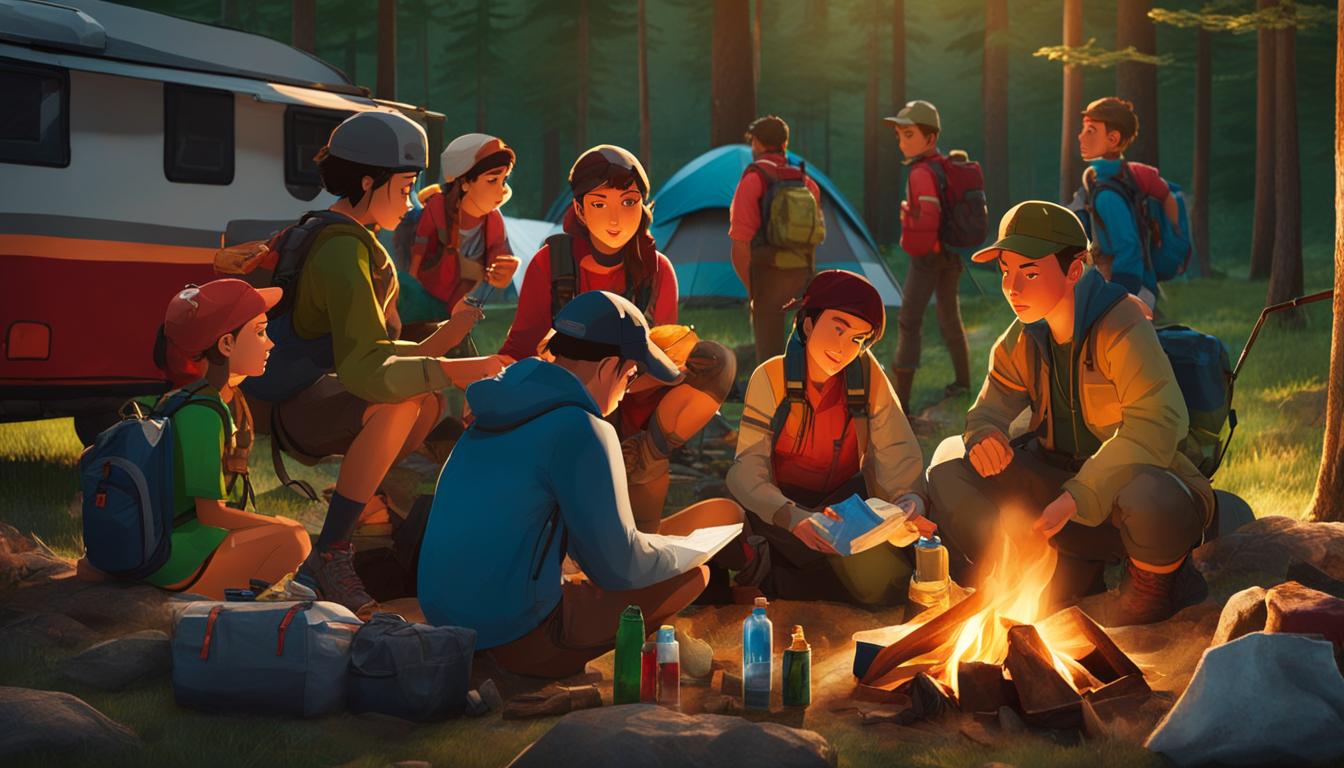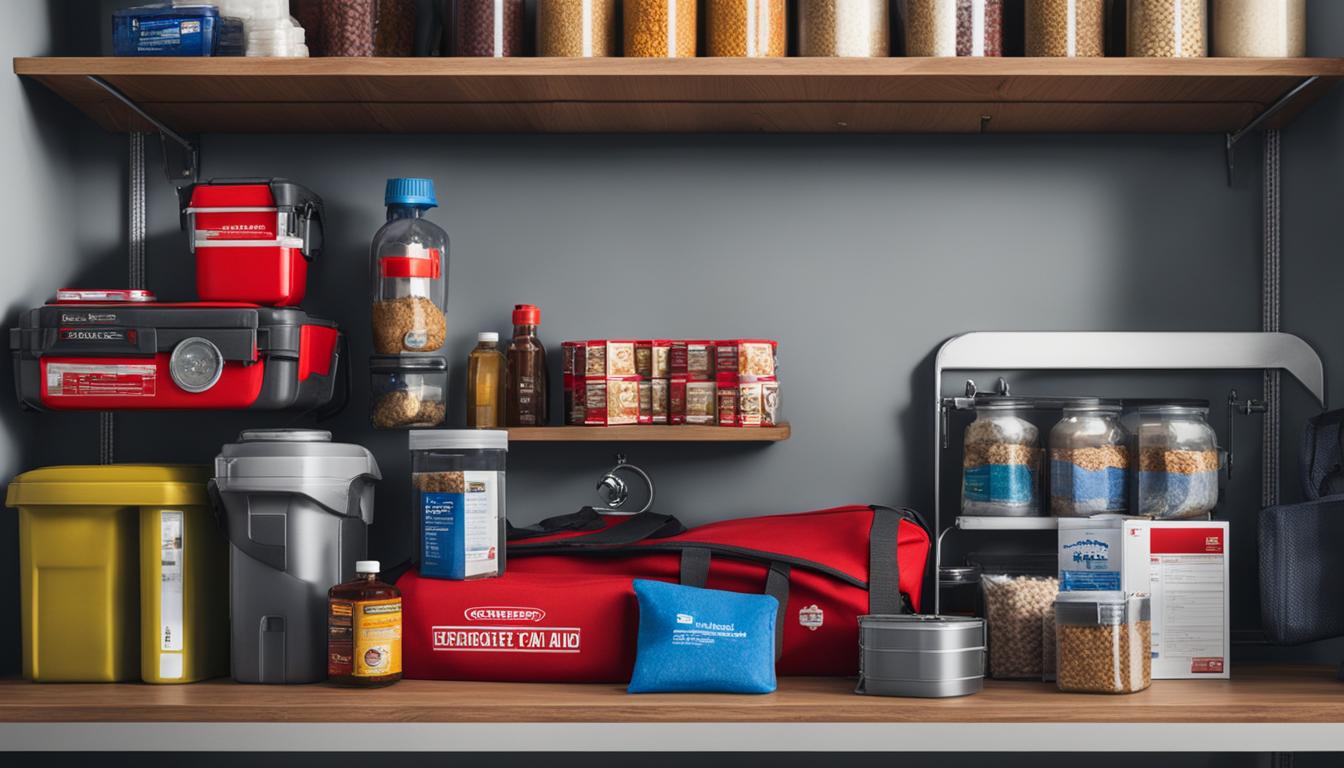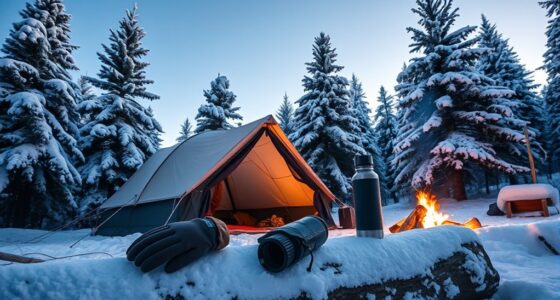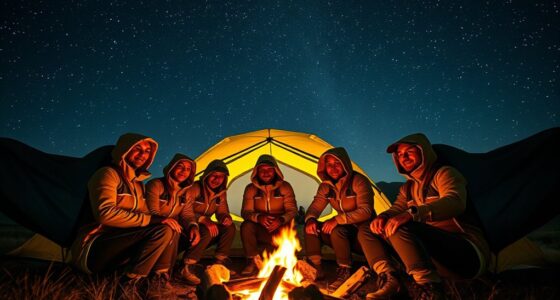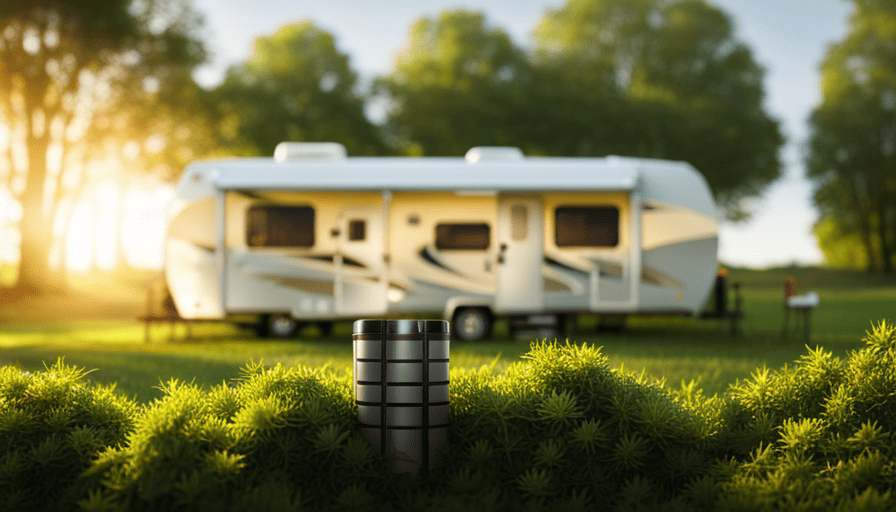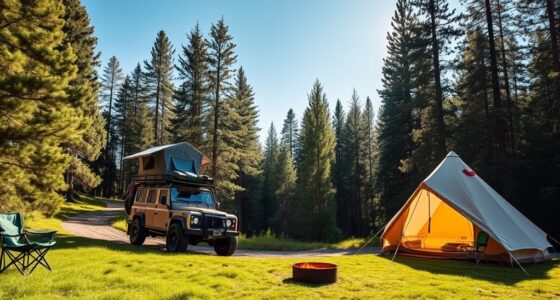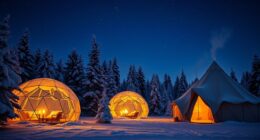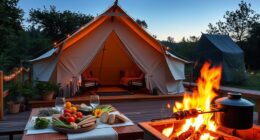Camping can be an amazing experience, but it’s crucial to focus on safety. By adhering to these important camping safety guidelines, we can guarantee a secure and pleasurable journey. Remember to pack an adequate amount of water and food in secure containers, properly store food to avoid attracting wildlife, practice food safety measures, select a suitable campground location and shelter, monitor the weather forecast, have a first aid kit ready, protect ourselves from bugs and sunburn, follow campfire safety procedures, and drive carefully.
Key Takeaways:
- Bring plenty of water for hydration and safety.
- Properly store food to prevent wildlife encounters.
- Practice food safety to prevent illness.
- Choose the right campground site and shelter.
- Stay updated on the weather forecast.
Bring Plenty of Water for Hydration and Safety
When embarking on a camping adventure, it is essential to prioritize hydration and ensure you have ample water supply throughout your trip. Hydration is crucial for your overall well-being and safety in the great outdoors. We recommend packing a solid 3- to 5-day supply of bottled water, as relying on campsites to provide enough water may not always be reliable.
While some campsites may have access to water sources, it’s important to check for signs or ask park officials if the water is safe to drink. Drinking contaminated water can lead to illnesses and ruin your camping experience. If safe drinking water is not available, you can boil the water for one minute or use a filtering system to ensure it is safe for consumption.
Another useful tip for staying hydrated on your camping trip is to pack electrolyte packets. These packets can be a great addition to your water supply, helping replenish essential minerals and electrolytes lost through sweating and physical activity.
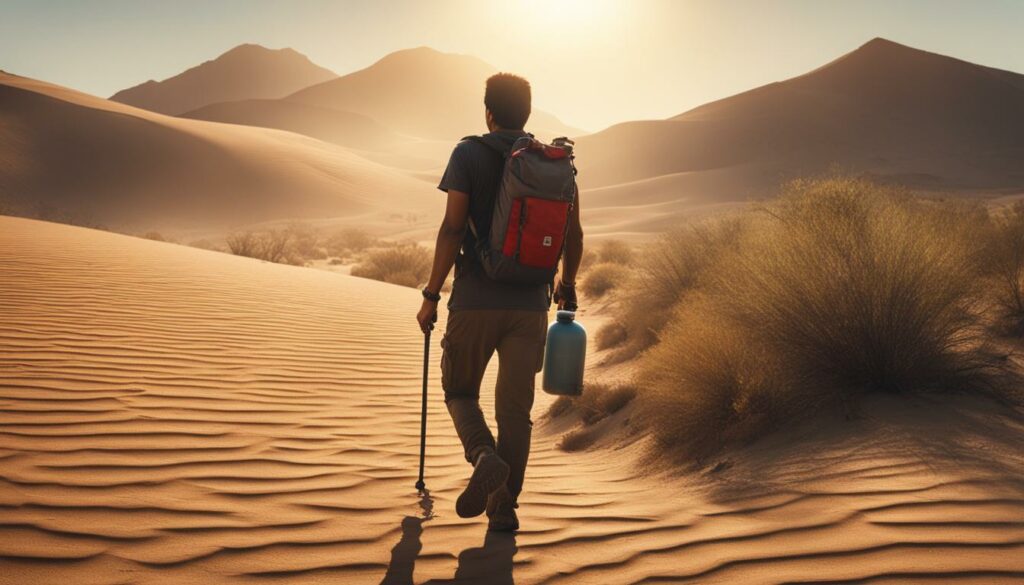
Stay Hydrated, Stay Safe
Remember, staying hydrated is not only important for your comfort but also for your safety. Dehydration can lead to fatigue, dizziness, and even heatstroke, especially during hot summer months. By bringing plenty of water and making hydration a priority, you can ensure that you have a safe and enjoyable camping experience. Don’t forget to stay hydrated and drink water regularly!
| Hydration Tips | Camping Safety Precautions |
|---|---|
| Bring a 3- to 5-day supply of bottled water | Check if the water at campsites is safe to drink |
| Boil water for one minute or use a filtering system if safe drinking water is not available | Consider using electrolyte packets for added hydration |
“Staying hydrated is a key aspect of camping safety. By bringing enough water and ensuring its safety, we can prevent dehydration and enjoy our outdoor adventures to the fullest.”
Properly Store Food to Prevent Wildlife Encounters
One of the most important camping safety guidelines is properly storing food to prevent encounters with wildlife. Keeping your food secure not only protects you and your fellow campers but also helps preserve the natural habitat for animals. Here are some essential tips for storing food while camping:
Table: Food Storage Guidelines
| Guidelines | Explanation |
|---|---|
| Use waterproof containers | Waterproof containers will help keep your food dry and protect it from potential rain or moisture. |
| Keep food inside a cooler | Using a cooler not only helps maintain the freshness of your food but also adds an extra layer of protection against wildlife. |
| Store food in designated bear lockers or suspend it | In bear country, it is crucial to follow specific rules about food storage. Use designated bear lockers if available or suspend your food between two trees at least 12 feet off the ground. |
| Keep canned goods, toiletries, drinks, and cooking utensils away from animals’ reach | These items can still attract wildlife, so make sure to store them in a safe and secure place. |
Remember, proper food storage is not only about your safety but also about respecting and protecting wildlife. By following these guidelines, we can ensure a harmonious coexistence with nature during our camping adventures.
By taking these precautions and being responsible with our food, we can minimize the risk of wildlife encounters and help preserve the natural environment for future generations to enjoy.
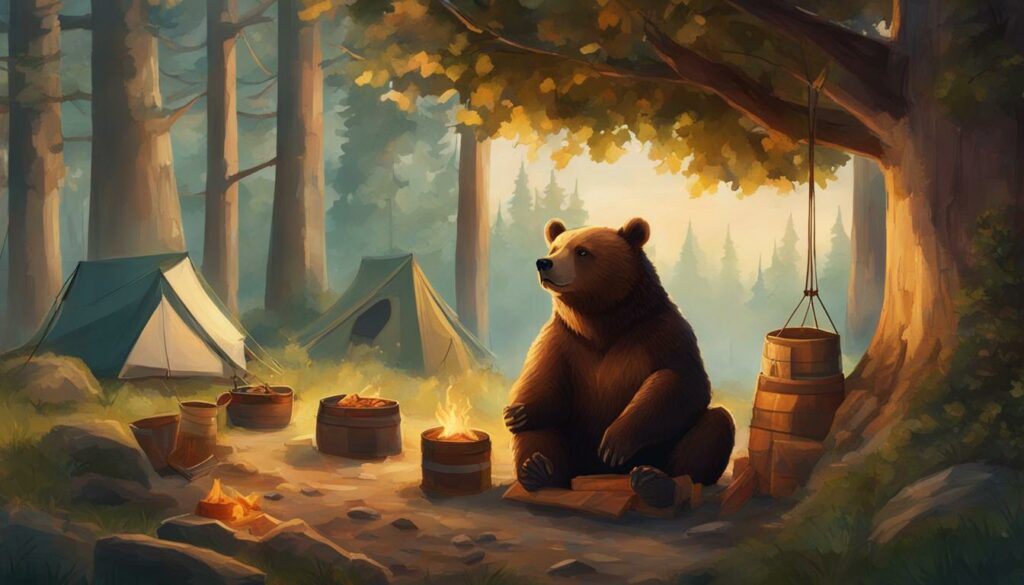
Practice Food Safety to Prevent Illness
When it comes to camping, food safety is of utmost importance to prevent illnesses and ensure a healthy trip. By following some simple guidelines, you can minimize the risk of food-borne illnesses and enjoy your outdoor adventure to the fullest.
Wash Your Hands and Keep Raw and Cooked Foods Separate
Food Safety Tip 1: Always remember to wash your hands thoroughly with soap and water before handling any food. If soap and water are not available, use hand sanitizers to maintain proper hygiene. Furthermore, it’s essential to keep raw and cooked foods separate to avoid cross-contamination. Use different cutting boards and utensils for raw and cooked foods, and always store them in separate containers.
Cook Your Food at the Right Temperature
Food Safety Tip 2: Cooking your food at the correct temperature is crucial to kill harmful bacteria and ensure it is safe to eat. Use a food thermometer to check the internal temperature of meat, poultry, and seafood. The safe temperature for cooking different types of food varies, so refer to the USDA guidelines for specific recommendations. Remember to clean the thermometer before and after each use to prevent cross-contamination.
Chill Your Food Promptly and Have a Well-Stocked First Aid Kit
Food Safety Tip 3: After cooking, it’s crucial to chill your food promptly to prevent bacterial growth. Store leftovers in insulated coolers with ice or freezer packs to maintain a safe temperature. Additionally, having a well-stocked first aid kit is essential while camping. Include items like moleskin or blister protection to address any foot issues that may arise from hiking or walking long distances.
| Food Safety Tips | Summary |
|---|---|
| Wash your hands and keep raw and cooked foods separate | Proper hand hygiene and preventing cross-contamination are essential for food safety. |
| Cook your food at the right temperature | Using a food thermometer ensures food is cooked to a safe temperature, eliminating harmful bacteria. |
| Chill your food promptly and have a well-stocked first aid kit | Properly storing and chilling food prevents bacterial growth, while a well-equipped first aid kit can address any minor injuries or issues that may arise. |
By practicing food safety measures, you can protect yourself and your fellow campers from food-borne illnesses. Remember to wash your hands, keep raw and cooked foods separate, cook food at the correct temperature, and promptly chill any leftovers. We hope these tips help you have a safe and enjoyable camping experience!
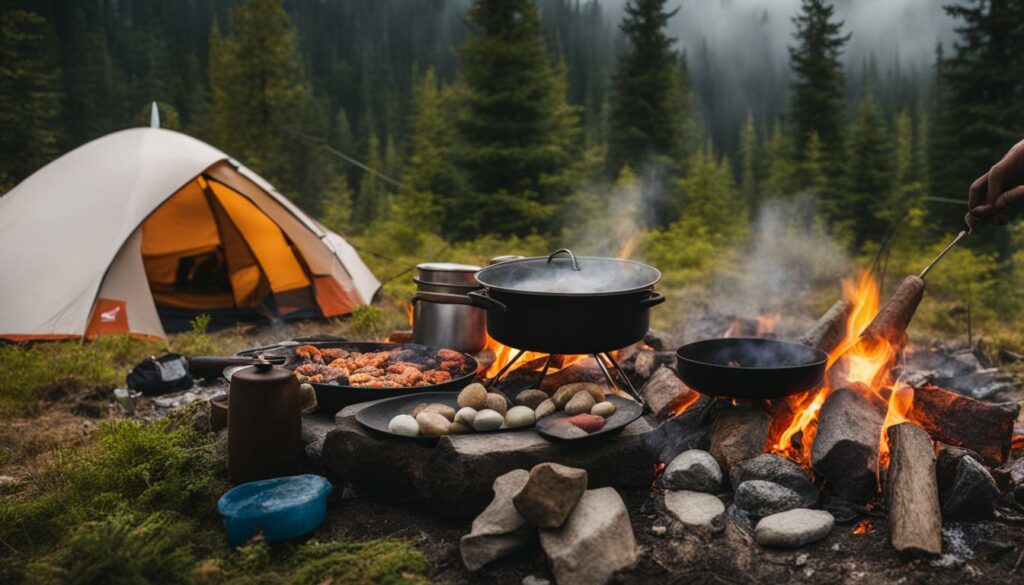
Choose the Right Campground Site and Shelter
When it comes to camping, selecting the right campground site and shelter is crucial for a safe and enjoyable experience. Consider your unique needs and preferences when making this decision. Take into account factors such as physical limitations, age, and medical requirements. Whether you prefer a tent, cabin, or RV, choosing a site with suitable amenities is important.
Look for campgrounds that offer picnic tables, nearby restrooms, fire rings, and spacious areas. These amenities can greatly enhance your camping experience and ensure your comfort and convenience. Research the campground or park’s website to find out what amenities are available and plan accordingly.
Additionally, consider the location and surroundings of the site. Are you looking for a secluded spot or do you prefer to be close to other campers? Take into account factors like noise level, proximity to hiking trails or water bodies, and the type of environment you want to immerse yourself in. By choosing a campground site and shelter that aligns with your preferences and needs, you’ll set yourself up for a successful camping adventure.
Table: Comparison of Campground Amenities
| Campground | Picnic Tables | Nearby Restrooms | Fire Rings | Spacious Areas |
|---|---|---|---|---|
| Campground A | Yes | Yes | Yes | No |
| Campground B | Yes | Yes | No | Yes |
| Campground C | No | Yes | No | Yes |
Table: Comparison of campground amenities.
By referring to this table, you can easily compare the amenities offered by different campgrounds and make an informed decision based on your preferences. Remember, a well-chosen campground site and shelter can greatly contribute to the overall enjoyment and safety of your camping trip.

Stay Updated on the Weather Forecast
Staying informed about the weather forecast is crucial for a safe and enjoyable camping experience. Weather conditions can change rapidly, so it’s important to check the forecast regularly.
When planning your trip, be sure to consider both daytime and nighttime conditions. Pack appropriate clothing and gear based on the projected temperature, precipitation, and any other relevant weather factors. It’s better to be prepared for changing weather conditions than to be caught off guard.
Having rain protection, such as waterproof jackets, pants, and tarps, is essential for staying dry during unexpected showers or storms. Additionally, packing extra layers of clothing will help you stay warm if the temperature drops. Remember, it’s easier to remove layers if you’re too warm, but it’s challenging to stay warm without them.
By staying updated on the weather forecast, you can make informed decisions about your camping activities and ensure that you have a safe and enjoyable time outdoors.
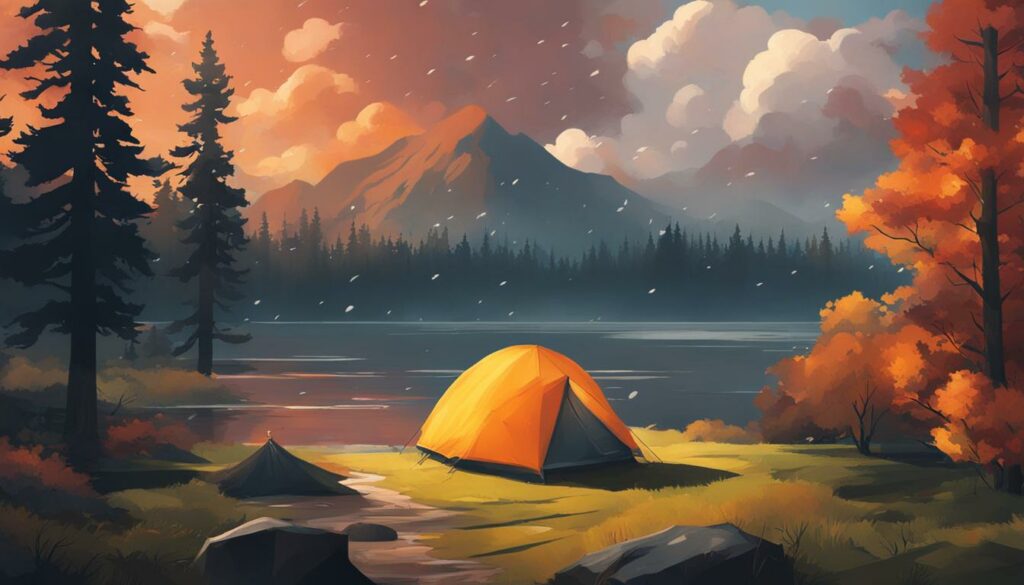
Additional Tips for Weather Safety:
- Bring a portable weather radio or download a reliable weather app to receive real-time updates during your trip.
- Avoid setting up your campsite in low-lying areas or near bodies of water that can flood during heavy rain.
- Seek shelter immediately if you hear thunder or see lightning. Move to a sturdy building or vehicle and stay inside until the storm passes.
- If severe weather is expected, consider rescheduling your camping trip or seeking shelter at a nearby campground with better facilities.
Remember, it’s always better to be safe than sorry when it comes to weather conditions. By staying informed and prepared, you can have a successful camping trip despite any unexpected weather challenges.
| Weather Forecast | Daytime Temperature | Nighttime Temperature | Precipitation |
|---|---|---|---|
| Monday | 75°F | 55°F | Partly cloudy |
| Tuesday | 80°F | 60°F | Scattered showers |
| Wednesday | 70°F | 50°F | Sunny |
Camping Safety Essentials: Have a First Aid Kit on Hand
Accidents can happen anywhere, including while camping. That’s why it’s crucial to be prepared and have a first aid kit readily available. Whether you purchase a pre-made kit or assemble your own, make sure it includes all the essentials to handle common camping injuries and emergencies.
Here are some items that should be included in your camping first aid kit:
- Band-aids in various sizes
- ACE bandages for sprains and strains
- Antibiotic cream or ointment for wound care
- Antihistamines for allergic reactions
- Alcohol wipes for cleaning wounds
- Gauze pads and adhesive tape for dressing larger wounds
- Imodium for diarrhea relief
- Painkillers for headaches, muscle aches, and other pain
- Blister protection such as moleskin or blister bandages
It’s also important to consider any specific medical needs you or your camping companions may have. If anyone requires prescription medications, make sure they are included in the first aid kit. Additionally, if you’ll be camping in an area where specific dangers exist, such as venomous snakes or severe allergies, it may be advisable to pack additional items like snake bite kits or EpiPens.
Remember, the goal of the first aid kit is to provide prompt and effective care in case of an emergency. It’s always better to have these supplies on hand and not need them than to find yourself ill-prepared in a time of need. Camp safely and confidently with a well-stocked first aid kit.
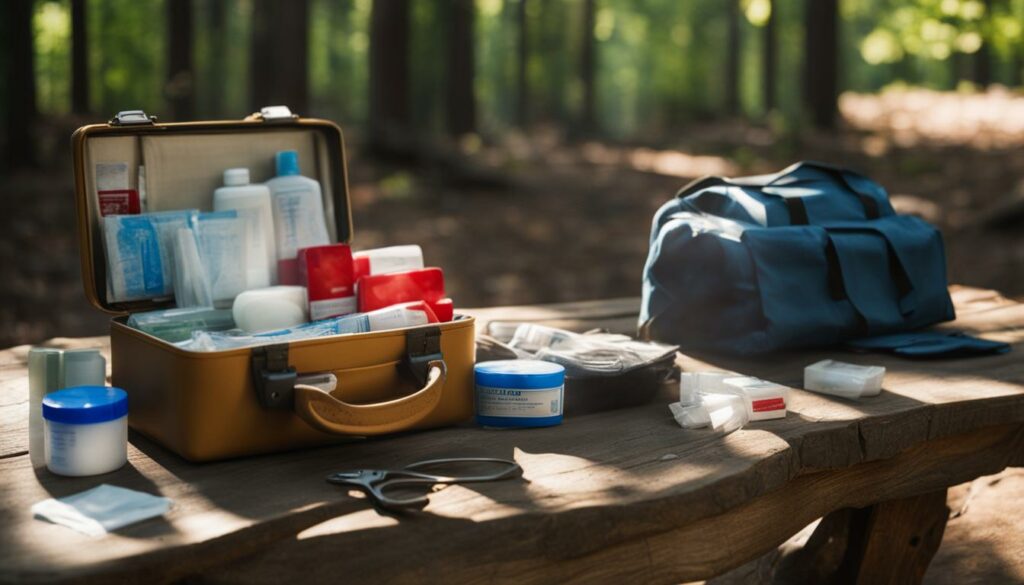
Source:
This first aid kit guide is based on personal camping experiences and recommendations from wilderness safety experts.
Protect Yourself from Insects and Sunburn
While enjoying the great outdoors, it’s important to protect yourself from insects and sunburn to ensure a safe and comfortable camping experience. Here are some essential tips:
1. Apply Sunscreen
Before heading out for your camping adventure, apply sunscreen to all exposed areas of your skin. Don’t forget to cover commonly overlooked areas like your ears and the tops of your feet. Opt for a broad-spectrum sunscreen with an SPF of 30 or higher to protect against both UVA and UVB rays.
2. Use Insect Repellent
Prevent insect bites by using an insect repellent containing DEET. Apply it to your exposed skin and clothing. Remember to follow the instructions on the product label for proper application. Additionally, wearing long-sleeved tops and long pants can provide an extra layer of protection.
3. Check for Ticks
Ticks can carry diseases like Lyme disease, so it’s crucial to check for ticks regularly. Conduct a thorough tick check on yourself, your family members, and your pets. If you find a tick, remove it promptly and properly using tweezers or a tick removal tool.
4. Proper Food and Drink Storage
Properly storing your food and drink containers is essential to prevent attracting insects. Keep all food in airtight containers and store them inside a cooler. Make sure to also dispose of any leftover food properly. Don’t leave food or drink containers out overnight as this can attract unwanted visitors.
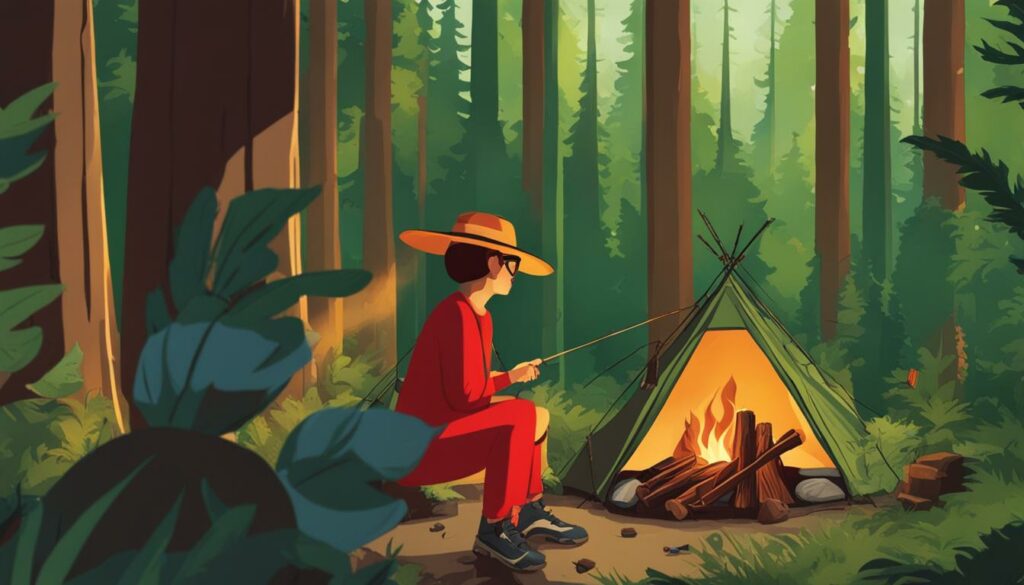
By following these tips, you can protect yourself from insects and sunburn during your camping trip. Remember to stay vigilant and take necessary precautions to ensure a safe and enjoyable outdoor experience.
Practice Campfire Safety
When it comes to camping, campfires are often a central part of the experience. However, it’s essential to prioritize campfire safety to prevent the risk of wildfires and ensure the safety of yourself and other campers. By following these camping safety rules and precautions, you can enjoy a cozy campfire without putting yourself or the environment at risk.
Choose Designated Fire Areas
When setting up a campfire, always choose designated fire areas whenever possible. These areas are specifically designed for campfires and are equipped with proper safety measures. They are usually located away from flammable items and in areas where the risk of spreading fire is minimal. Using these designated areas not only ensures your safety but also protects the surrounding environment.
Maintain a Safe Distance
Whether you’re using a designated fire area or creating your own fire pit, it’s crucial to maintain a safe distance from flammable items. Keep your campfire at least 10 feet away from trees, tents, and other combustible materials. Clear the area around your fire pit by removing dry leaves, twigs, and debris that could easily catch fire. By doing so, you reduce the risk of embers spreading and potentially causing a wildfire.
Never Leave Your Campfire Unattended
One of the most important rules of campfire safety is to never leave your fire unattended. Always have a responsible adult present who can monitor the fire and ensure it is fully extinguished before leaving the campsite or going to sleep. Even a small spark can quickly turn into a dangerous wildfire if left unattended. Remember, it’s better to be safe than sorry.
Have a Bucket of Water Nearby
In case of an emergency, it’s essential to have a bucket of water or a water source nearby. This can be used to quickly extinguish the fire or control any unexpected flare-ups. Keep the bucket filled with water at all times and make sure everyone in your camping group knows its location. Being prepared with a water source can make a significant difference in preventing the spread of a fire.
Following these campfire safety guidelines will help ensure a safe and enjoyable camping experience for everyone. By being responsible and proactive, you can enjoy the warmth and beauty of a campfire while minimizing the risk of accidents and wildfires. Remember, camping safety is our top priority!
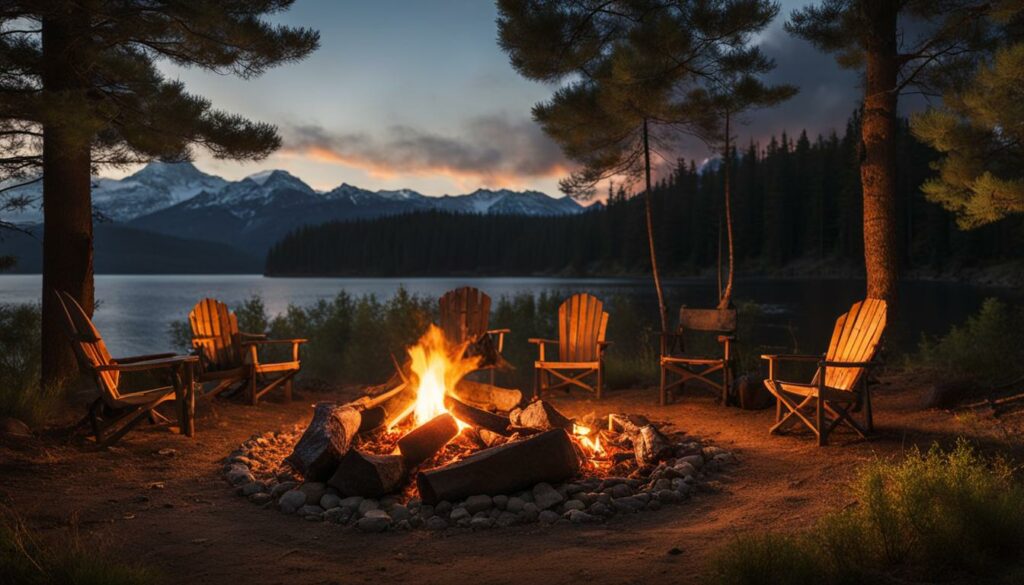
Conclusion
Camping is a wonderful outdoor adventure that allows us to connect with nature and create lasting memories. However, it is essential to prioritize safety to ensure a smooth and enjoyable trip. By following these essential camping safety tips, you can have peace of mind and focus on making the most of your time in the great outdoors.
First and foremost, always remember to bring ample water for hydration and safety. Staying hydrated is crucial, so make sure to pack a solid supply of bottled water and check if the campground provides safe drinking water. Additionally, properly storing food is crucial to prevent wildlife encounters. Use waterproof containers and keep them securely stored to avoid attracting wild animals.
Food safety should also be a priority to prevent any illnesses. Wash your hands before eating, keep raw and cooked foods separate to avoid contamination, and cook food at the right temperature. It’s also important to choose the right campground site and shelter that meets your specific needs and preferences. Consider factors like amenities, accessibility, and special requirements.
Stay updated on the weather forecast to be prepared for any changes or emergencies. Having a first aid kit on hand is also vital in case of any accidents or injuries. Protect yourself from insects and sunburn by applying sunscreen and using insect repellent. Lastly, practice campfire safety to prevent wildfires and ensure the safety of yourself and others at the campsite.
Remember, safety is the key to a successful camping trip. By incorporating these camping safety tips into your plan, you can have a safe and enjoyable experience in the great outdoors. So pack your bags, gather your friends and family, and embark on an adventure filled with unforgettable moments and beautiful memories.
What Essential Safety Tips Should I Keep in Mind for Every Camping Adventure?
When embarking on a camping adventure, it’s crucial to remember some ultimate camping essentials記事 to ensure safety. Always bring a first aid kit, adequate clothing, and proper footwear. Familiarize yourself with the local wildlife and potential hazards. Also, be sure to share your trip details with someone you trust.
FAQ
What are some essential camping safety tips?
Some essential camping safety tips include bringing plenty of water, properly storing food to prevent wildlife encounters, practicing food safety, choosing the right campground site and shelter, staying updated on the weather forecast, having a first aid kit on hand, protecting yourself from insects and sunburn, practicing campfire safety, and driving safely.
How much water should I bring when camping?
It is crucial to bring an ample supply of water when camping. A solid 3- to 5-day supply of bottled water is recommended. Do not rely on campsites having enough water. Check for signs in parks to determine if the water is safe to drink. If safe drinking water is not available, boil the water for one minute or use filtering systems. Electrolyte packets can also be helpful for hydration.
How should I store my food to prevent wildlife encounters?
To keep your food secure and avoid attracting wild animals, store your food in waterproof containers and keep them inside a cooler. If camping in bear country, use designated bear lockers or suspend your food between two trees at least 12 feet off the ground. Follow specific rules about food storage in national parks and keep items like canned goods, toiletries, drinks, and cooking utensils away from animals’ reach.
What are some food safety practices to follow while camping?
To stay healthy and prevent food-borne illnesses while camping, follow some simple food safety practices. Always wash your hands before eating and use hand sanitizers if soap and water are not available. Keep raw and cooked foods separate to avoid cross-contamination. Cook your food at the right temperature, and if not cooking immediately, chill it promptly in an insulated cooler. Consider including essential items like moleskin or blister protection in your first aid kit if doing a lot of hiking.
How do I choose the right campground site and shelter?
When selecting a campground site and shelter, consider your unique needs and preferences. Factors like physical limitations, age, and medical requirements should guide your decision-making process. Whether you opt for a tent, cabin, or RV, make sure to choose a site that offers amenities like picnic tables, nearby restrooms, fire rings, and spacious areas. Check the campground or park’s website for available amenities and plan accordingly.
Why is it important to stay updated on the weather forecast?
Keeping an eye on the weather forecast is essential to ensure a safe camping trip. Weather conditions can change quickly, so it’s important to check the forecast for both daytime and nighttime conditions. This will help you pack accordingly, considering factors like rain, snow, and temperature fluctuations throughout the day. Always have rain protection and extra layers of clothing on hand.
What should I include in my first aid kit for camping?
Accidents can happen anywhere, including while camping, so it’s important to be prepared with a first aid kit. Essentials to include are band-aids, ACE bandages, antibiotic cream, antihistamines, alcohol wipes, gauze, Imodium, painkillers, and blister protection. Consider any specific medical needs and include relevant medications.
How can I protect myself from insects and sunburn while camping?
Take steps to protect your skin from sunburn and insect bites while camping. Apply sunscreen to all exposed skin areas, including often overlooked areas like your ears and the tops of your feet. Use insect repellent containing DEET and wear long-sleeved tops and long pants to prevent insect bites. Check for ticks daily and remove them promptly. Avoid feeding wildlife and keep food and drink containers properly stored to prevent attracting insects.
What are some tips for practicing campfire safety?
To ensure campfire safety, choose designated fire areas whenever possible and maintain a safe distance from flammable items. Never leave a campfire unattended and always have a bucket of water nearby for emergencies. Completely drown the fire before leaving or going to sleep. Follow specific rules regarding campfires in different campgrounds and national parks.

